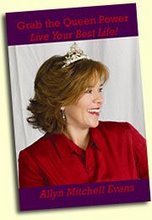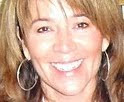Sidetracked
I had big plans to return to work on the 8th of January. Fate had other plans. Called to report for jury duty that day, I was selected for the first trial. The trial took four days. Then I took two days to recover.
Instead of having time to write, I have been handling administrative tasks. Not too long ago, my dear friend and colleague, Carolyn Howard-Johnson, shared a story with me. I asked her if I could reprint it in my blog on a future date. Today's the day!
Life Begins With Cancer by Carolyn Howard-Johnson
The day after my biopsy, my husband and I drove to Las Vegas on a business trip, never thinking about possibilities. We stopped at the state line for a ride on the giant Ferris wheel. We shelled giant prawns for lunch at the Stardust buffet. We slid quarters into slot machines.
That was not a bad approach to dealing with unpleasant thing. There is no reason to project abject possibilities that may never come to pass onto the present. Denial can sometimes be useful. On the other hand, it often keeps one from examining one’s own behavior. I share this anecdote because it illustrates how thoroughly denial had become entrenched in my life.
I was raised in times that were not easy for women. Most of the barriers I faced were ones that couldn’t be seen nor acknowledged because I didn’t know they were there. They crept up silently on padded feet and, if I sensed them at all, I choose not to turn and face them.
The same day we left for the glitzy city, I received the news we had to return to California so I could begin autogenous blood donations and that the operation would be scheduled for a date as soon as they had enough blood. This was the age of the AIDS scare and blood from any source other than one's own veins was suspect. I reassured myself that I wasn’t nervous, that cancer was not a terrifying word and that AIDS was not a consideration with this procedure.
My husband was also up to the task. “We won’t work today. We’ll just take off, have some fun and drive back tonight.”
We were like two peas—frozen and unthinking. We’d both try anything other than just saying, “Gee, I’m scared.”
I almost went along with the plan to ignore our feelings. The car trip home forced me to think and I realized—sort of knew at a cellular level--
that I had to do more than donate blood to myself and that cancer doesn’t just happen.
This theory--the one that cancer doesn't just happen-- is easily misunderstood. I don’t believe those of us who have it are being punished, but I do believe that it follows those of us who haven’t taken care of our own needs. The way we relate to ourselves, more than the way we relate to the world, is a factor in our health. When I tried to excuse those thoughts, it was an indication that I needed to look into my kaleidoscope one more time—at its fragmentation as well as its beauty—and to make sense of the patterns I saw there.
I began to read. I utilized yoga and a vitamin regimen that I started when I first found little chicken scratches around the corners of my eyes. I used vitamin E oil on my incisions.
“You’re healing so quickly,” my doctor said. “What are you doing?”
“Yoga and snake oil.”
He just shook his head.
The next step after healing the physical scars was to heal my life.
My second epiphany came when I read Deepak Chopra’s Ageless Body, Timeless Mind. He said that those who live until they are fifty in these times might very likely see their hundredth year. It was like a sunrise, all pink and aqua, in my brain. To think that I might have plenty of time to do whatever I wanted, in spite of the fact that I had thrown away a writing career -- one of my greatest loves -- in spite of the fact that I had experienced cancer. I knew right down to my toes that I might have even more time for my second life than my first because I wouldn’t have to spend the first twenty years preparing for adulthood.
That was when I faced the biggest denial factor in my life—the one that I think “caused” my cancer.
Many girls in my generation were taught to deny their own calling. If their parents didn’t do that, it was likely that society did.
In the place (Utah) and time (1950s) when I was growing up, women had a notion of who they should be, could be and, mostly, they got it from those around them. Many of them couldn’t see the difference between society’s expectations and their own.
“Be a teacher because you can be home the same hours as your children,” my mother said.
“Learn to type so you can make a living if your husband dies.”
I had always wanted to sit in a forest or newsroom with a pencil in my hand. I wanted to write the next Gone With The Wind only about Utah instead of about the South. I had a plan that was, itself, gone with the wind.
Writing didn’t fit any of the requirements for women. So, when I gave it up, it didn’t feel like I was giving up much.
I met a handsome young man and we were married. His career took precedence; that was simply how it was done. Then there were two children, carefully planned, because that was how it should be done. By the 70s, we both yearned for a career that would allow us to spend time with our children and be in command of our own lives. My dream was a victim of the status quo.
My husband and I built a business. We raised a lawyer and a mathematician, grew in joy with a grandson, lived through floods and moves, and enjoyed travel. For forty years I didn’t write and, during that time, there were changes. Women had more choices; they had become more aware. The equipment, gears and pulleys were in place for a different view on life, but I was so practiced in all my old ways of doing things, I couldn’t see it. In midlife, I became aware that there was an empty hole where my children had been but also that the hole was more vast than the space vacated by them. Cancer filled it. When Mr. Chopra’s philosophy appeared on a page in black and white, I knew I not only would be able to write, I would need to write.
I sat down and began to write the “Great Utah Novel.” The process forced me to return to classes. Writing a novel wasn’t as easy as I thought it would be. At 58, I might not have to learn speech and motor skills and the ABCs again, but there sure was a lot I didn’t know about writing.
Much of what I wrote about is my own story. If my novel were a tapestry, the warp would be real but the woof would be the stuff of imagination—real fiction. For me it was more therapy, but this time in my own ink, not someone else’s.
I think I bring a unique vision to my work. I think I tell a story about Utah in the 50s that could only be told by someone who lived in that time and place and who was a part of the two cultures—the Mormon and the non-Mormon—that makes it a whole.
I’m glad that I waited until I was sixty. I also like being proof that it is never too late to revive a dream nor to conquer adversity.
Cancer was the first step of a staircase. It led me to new levels of understanding about nutrition, career, spirituality. I have even written a poem about a beautiful black crow—the image of death—that sits on my shoulder and reminds me that each day is beautiful, each day is to be lived. For me, cancer was a gift. I intend to keep learning from its presence.
----------
(Carolyn Howard-Johnson’s novel, This Is The Place, was published by AmErica House
exactly ten years after she was diagnosed with cancer. The book explores intolerance. That along with a renewed interest in genealogy and Carolyn’s unique insight into the place she was raised makes this novel not only timely but also essential. You can read the first chapter FREE by e-mailing: carolynhowardjohnson@sendfree.com or go to http://carolynhoward-johnsson.com/. Check out the other award-winning books she has written since those days battling cancer and her own life-habits. Her blog is at www.sharingwithwriters.blogspot.com.
www.allynevans.com
skip to main |
skip to sidebar

Looking for QueenPower.com?
You've come to the right place! Pull up your throne and stay awhile....
Don't forget to visit my main website: http://www.allynevans.com/
Don't forget to visit my main website: http://www.allynevans.com/
Subscribe via email

Check Out New Book for Teens! I'm a contributor!
Twitter Dee Twitter Dum
Blog Subject Index
- About Us (1)
- adolescence (1)
- assertiveness (2)
- breaking bad habits (1)
- cancer (1)
- change (6)
- children (4)
- choices (24)
- confidence (9)
- Dreams (2)
- epiphany (14)
- fears (5)
- featured guest (7)
- frustration (3)
- general (4)
- goals (4)
- helping others (5)
- humor (9)
- inspiration (45)
- Intuition (2)
- keeping promises (1)
- late bloomers (7)
- losing weight (6)
- mailbag (2)
- mean voice (8)
- miracles (1)
- opinion of others (5)
- parenting advice (4)
- purpose (2)
- Recommended Books (2)
- self bashing (12)
- self esteem (2)
- self help (38)
- self sabotage (2)
- speaker (1)
- unconditional love (1)
- voices of women (1)
- writing (1)
Our Subscription Policy
Subscribing to the blog means whenever something is posted you will receive an email notification. Makes things easy, doesn't it?
Oh and we NEVER share email addresses with others. Pinky swear!
Love comments.
Oh and we NEVER share email addresses with others. Pinky swear!
Love comments.
Check out my article...
in the Eleusis.

It started with Grab the Queen Power
Read About My Experience as a Juror on a Meth Case. It took months to recover.
About Me

Books I Highly Recommend
Friends and Favorites


Is it Yours?
ShareThis













